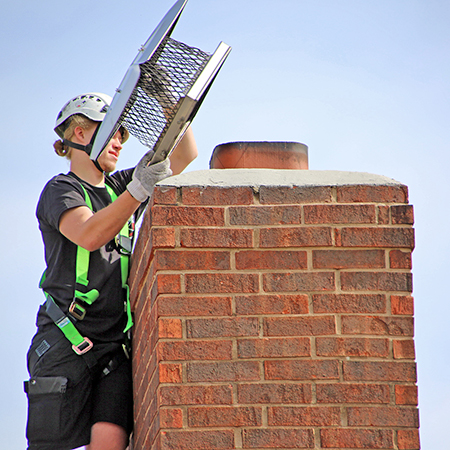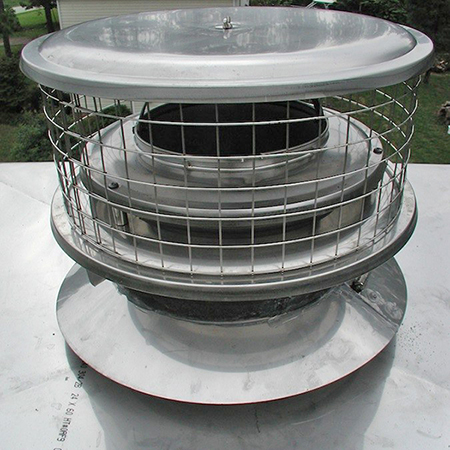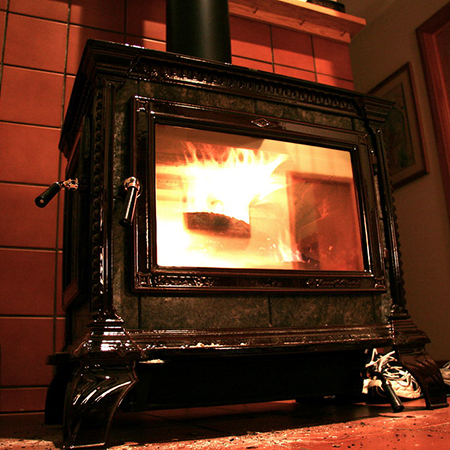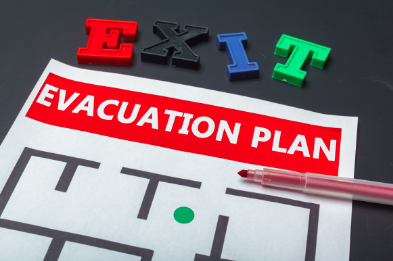When Should A Chimney Cap Be Replaced?
 The chimney cap is one of the most vital parts of a chimney. Its primary purpose is to protect the masonry chimney crown & open flue. There are two kinds of chimney caps. Many fireplaces, especially in older homes, have an open style chimney cap that was made from leftover cement and mortar from the original chimney construction. It is sloped to help push water and snow away from the chimney, but the flue is still exposed. The other kind of cap contains a metal mesh screen that covers the flue opening. It has an added advantage of helping to prevent animals, pests, and debris from obstructing the flue while still allowing smoke and fumes to vent. Regardless of the type of chimney cap you have, it will eventually need replacement.
The chimney cap is one of the most vital parts of a chimney. Its primary purpose is to protect the masonry chimney crown & open flue. There are two kinds of chimney caps. Many fireplaces, especially in older homes, have an open style chimney cap that was made from leftover cement and mortar from the original chimney construction. It is sloped to help push water and snow away from the chimney, but the flue is still exposed. The other kind of cap contains a metal mesh screen that covers the flue opening. It has an added advantage of helping to prevent animals, pests, and debris from obstructing the flue while still allowing smoke and fumes to vent. Regardless of the type of chimney cap you have, it will eventually need replacement.
Water and debris in the firebox
Water is the mortal enemy of the chimney. It can soften the masonry leading to extensive damage and repairs. And if water and debris are getting into your fireplace, then smoke and fumes may also be invading your living space. When this occurs, the chimney cap should be inspected and replaced if damaged. Otherwise, you will need a more thorough inspection to determine the source of the water intrusion.
Your cap blew off
Although the chimney cap is tightly secured to the chimney crown, its continued exposure to strong winds and heavy rain could cause it to loosen or blow off the chimney. Also, your chimney cap may not have been installed correctly in the first place. The wrong size cap or incorrect installation can also cause it to separate from the chimney. When you look up at the roof and notice the chimney cap is missing, it is time for an immediate replacement.
Excessive presence of rust
 You should also replace the chimney cap when it begins to rust or corrode. The continuous exposure to moisture, creosote, and other contaminants can result in rust or corrosion and weaken its effectiveness. When the chimney cap is heavily rusted, it can easily rip apart. Even small animals looking for shelter can force their way through the weakened mesh and obstruct the flue.
You should also replace the chimney cap when it begins to rust or corrode. The continuous exposure to moisture, creosote, and other contaminants can result in rust or corrosion and weaken its effectiveness. When the chimney cap is heavily rusted, it can easily rip apart. Even small animals looking for shelter can force their way through the weakened mesh and obstruct the flue.
Your experiencing downdrafts
On windy days, a sudden gust of wind can force air straight down the stack. It can also be very messy when soot, creosote, and ash are blown into your living space. A damaged or missing chimney cap is usually the culprit. Replacing the chimney cap will minimize downdrafts.
A structurally sound and well-installed chimney cap is vital to preventing water intrusion and flue obstructions. It will also protect the chimney crown and minimize chimney repairs. If it’s been more than a year since your last chimney inspection, give us a call to schedule a visit. We will inspect the chimney cap and recommend replacement, if necessary. In most cases, we can install your new chimney cap during the same visit.
The post When Should A Chimney Cap Be Replaced? appeared first on Fluesbrothers Chimney Service.
 The quintessential wood stove is an indispensable source of heat for many homeowners, especially in older homes built before the arrival of central air. And since modern wood stoves are more environmentally friendly than ever before, they have grown in popularity. But whether you use a wood stove for primary or supplemental heating, you need to make sure you are operating the appliance safely.
The quintessential wood stove is an indispensable source of heat for many homeowners, especially in older homes built before the arrival of central air. And since modern wood stoves are more environmentally friendly than ever before, they have grown in popularity. But whether you use a wood stove for primary or supplemental heating, you need to make sure you are operating the appliance safely. The stovepipe vents the smoke and fumes in the wood-stove out through the chimney. It is unsafe to use a stovepipe without connecting it to an approved chimney system. A combination of high temperatures along with CO2 gases along with creosote buildup inside the stovepipe can start a fire. Periodically cleaning the stovepipe and ensuring it is correctly vented to the chimney reduces the risk of fire and carbon monoxide poisoning.
The stovepipe vents the smoke and fumes in the wood-stove out through the chimney. It is unsafe to use a stovepipe without connecting it to an approved chimney system. A combination of high temperatures along with CO2 gases along with creosote buildup inside the stovepipe can start a fire. Periodically cleaning the stovepipe and ensuring it is correctly vented to the chimney reduces the risk of fire and carbon monoxide poisoning.
 Today’s wood stoves make elegant and useful additions to any home. They’re efficient and beautiful and give you years of performance. You can enhance the performance and safety of your wood heating stove by following these seven tips.
Today’s wood stoves make elegant and useful additions to any home. They’re efficient and beautiful and give you years of performance. You can enhance the performance and safety of your wood heating stove by following these seven tips. The primary maintenance job with a
The primary maintenance job with a  We suggest that every household establish a family emergency action plan, discuss escape routes with family members, and locate fire extinguishers in your home. Additionally, you can conduct a mock fire drill with your family members to ensure you and your loved ones know how to get out safely. During this drill, outline meeting places that are at a safe distance from the home. Designate a neighbor to contact for help in the event of an emergency.
We suggest that every household establish a family emergency action plan, discuss escape routes with family members, and locate fire extinguishers in your home. Additionally, you can conduct a mock fire drill with your family members to ensure you and your loved ones know how to get out safely. During this drill, outline meeting places that are at a safe distance from the home. Designate a neighbor to contact for help in the event of an emergency.
 Home and work should have access to a list of emergency contact phone numbers in case of emergency. Remember that human nature is to panic in emergencies; therefore, basics such as important phone numbers and building floor plans should be posted on or with the emergency action plan.
Home and work should have access to a list of emergency contact phone numbers in case of emergency. Remember that human nature is to panic in emergencies; therefore, basics such as important phone numbers and building floor plans should be posted on or with the emergency action plan. Within the fireplace and chimney services industry, the 2016 scuffle between the Chimney Safety Institute of America (CSIA) and Angie’s List is fairly well-known. For those of you not familiar with the issue, here’s the thumbnail version.
Within the fireplace and chimney services industry, the 2016 scuffle between the Chimney Safety Institute of America (CSIA) and Angie’s List is fairly well-known. For those of you not familiar with the issue, here’s the thumbnail version. Individuals who hold these and other high-level certifications have demonstrated that they understand the multiple elements of a chimney’s operation and structure and have shown specific expertise in using the tools and equipment that are industry-standard in cleaning chimneys.
Individuals who hold these and other high-level certifications have demonstrated that they understand the multiple elements of a chimney’s operation and structure and have shown specific expertise in using the tools and equipment that are industry-standard in cleaning chimneys. Getting the most out of your fireplace and the wood you burn in it is easy, if you follow these six tips on efficient and safe
Getting the most out of your fireplace and the wood you burn in it is easy, if you follow these six tips on efficient and safe  Clean, unfinished wood and small amounts of newspaper are the only items that should burn in your fireplace. Never use the following:
Clean, unfinished wood and small amounts of newspaper are the only items that should burn in your fireplace. Never use the following:

 Getting a long and efficient life out of your wood stove and keeping your home and family safe when using it are important to every wood stove owner. Here are five operational and safety tips to follow for the best experience with your wood stove.
Getting a long and efficient life out of your wood stove and keeping your home and family safe when using it are important to every wood stove owner. Here are five operational and safety tips to follow for the best experience with your wood stove. More of a concern than built-up creosote inside your stove is the creosote that builds up inside the vent pipe, which you can’t see. Creosote forms when smoke is burned and can be flakey, sticky or hard within your flue pipe.WFD
More of a concern than built-up creosote inside your stove is the creosote that builds up inside the vent pipe, which you can’t see. Creosote forms when smoke is burned and can be flakey, sticky or hard within your flue pipe.WFD When the heat of summer is still bearing down and autumn is on the horizon, it’s the perfect time to prepare your fireplace and chimney for the cooler temperatures to come. As early as September but definitely by October, appointments with reputable chimney sweeps like the experts at Northeastern Chimney fill up quickly. Schedule an appointment for a
When the heat of summer is still bearing down and autumn is on the horizon, it’s the perfect time to prepare your fireplace and chimney for the cooler temperatures to come. As early as September but definitely by October, appointments with reputable chimney sweeps like the experts at Northeastern Chimney fill up quickly. Schedule an appointment for a  There are three levels of chimney inspections, and the details of each are outlined by the Chimney Safety Institute of America (CSIA).
There are three levels of chimney inspections, and the details of each are outlined by the Chimney Safety Institute of America (CSIA).